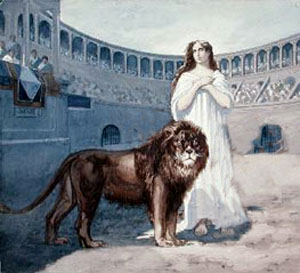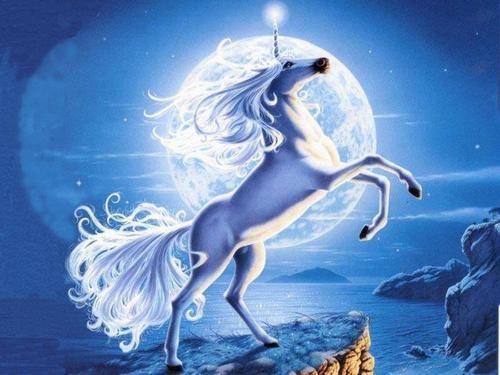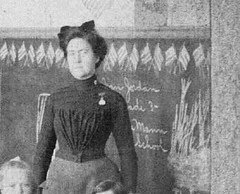Take, for instance, the unicorn.
This is a fairly common portrayal of this magnificent creature, and there's nothing wrong with it...but it irritates me almost more than I can say. You see, animals were once personifications of virtues: the lion stood for courage, the pelican for charity, the lamb for docility and gentleness, and so on. Now real animals, being real and inhabitants of this fallen world, don't exactly hold to the ideals. There's a reason certain symbols don't resonate with that particular virtue anymore: we learned too much about the animal for the image to stick.
The mythical creatures--at least, some of them--also stood for a particular virtue, or vice as the case may be. The griffin was a guardian, while the dragon stood alternately for guarding, or for greed and evil. The phoenix was a symbol of the Resurrection.
The unicorn, while apparently no one could quite agree on what it looked like, stood for some extremely high ideals. At one point in Church history, it was a symbol for both Christ and His Mother, and still stands as a symbol of purity. That sounds to me like something exceedingly beautiful and impressive, and not like something from My Little Pony.
And mythical creatures, unlike real ones, cannot be studied, and so, cannot diverge from their given path. Why, therefore, have we gone from this:
To this?
I strongly suspect it has something to do with our views on purity. For mythical symbols, it seems only natural that, once our views on their virtue chance, then they have to change along with them. For instance, what do the words 'purity' and 'chastity' immediately bring to mind for you? Chances are, it may be something like this.
Or this.
Now, I don't know if this will surprise you or not, but that's not what people used to think of those words, particularly people from the medieval period. In fact, what they saw--immediately--was probably something much closer to this.
Make no mistake about it: the people in medieval times weren't plaster statues. They had much of the same problems with purity and chastity as we did; that hasn't changed since the Fall. What they had was a clearer picture of the ideal, and an admiration--sometimes grudging, but admiration nonetheless. After all, they taught their kids stories about people like this:
 |
| Virgin martyrs. When you'd rather die in torment than give up your purity or faith, that means something. |
Where did the trouble start? I'm not sure I could pinpoint any real transition point, but I'm willing to bet it started roughly around the Protestant Reformation. And it may not have started specifically with Luther or Calvin; I'm sure plenty of bad Catholics were already dragging the virtue and its reputation through the mud. It probably had more to do with Henry the VIII, and his ham-handed demolition of convents and monasteries. Once the public view of purity and its goodness had disappeared, the mental view of it was just as likely to change.
And with the emergence of Puritanism, mythical symbols fell firmly by the wayside--especially symbols that smacked of "popery". The unicorn, with its connotations to both Jesus and Mary, would be especially despised, resulting in a complete lack of any such symbolism for years afterwards.
And then, a hundred or so years later, along came the Victorian Era, with its cheerful insistence on rewriting the old legends. This was most likely the time that the fluffy images of the unicorn started to surface, considering what they did to the realm of Faerie.
 |
| This... |
| Became this. |
It was also a time when purity became mixed with prudery. The unpleasant result still resonates in our culture, explaining why purity is such a foreign or distasteful concept to a lot of people.
The revolt against the Victorian Puritanism began the slow but steady slide downwards to the moral cesspool we find ourselves wallowing in today. And that, I believe, explains the revolt against the imagery of the unicorn. We know--if only by osmosis--what it is meant to stand for.
And perhaps the hearts of most of us yearn for this: the communion between Man and with something much greater. The singing joy of being in the presence of something so great, so beautiful, and so elusive. But there is a force in the world--hidden, but most assuredly there--which hates that which is great, beautiful, and good. It is a force which cannot see anything good without trying to tear it down and pervert it. I will not post any of the disgusting or even obscene images that came up when I searched for pictures of unicorns online, but they were there.
And that makes me wonder. Why such an attack against a symbol? We jeeringly tell people to 'get off their unicorn' when we want them to come to their senses. But the unicorn is no more imaginary than the griffin, the chimera, or the hippogriff. There are few to no cutesy or obscene images of the phoenix or the hydra. We never use these mythical beasts to sneer at those we think are living in a fantasy world. So why the unicorn?
I think it is a strike against its virtue. By turning the symbol into something cutesy, crass, narcissistic, or otherwise harmless or unappealing, we can ignore the truth that stands behind it. Because to our minds, purity looks like the unicorn. So if you can get the purity to look like this:
You can ignore it much more easily than if you knew, without a doubt, that it actually looks like this:






No comments:
Post a Comment